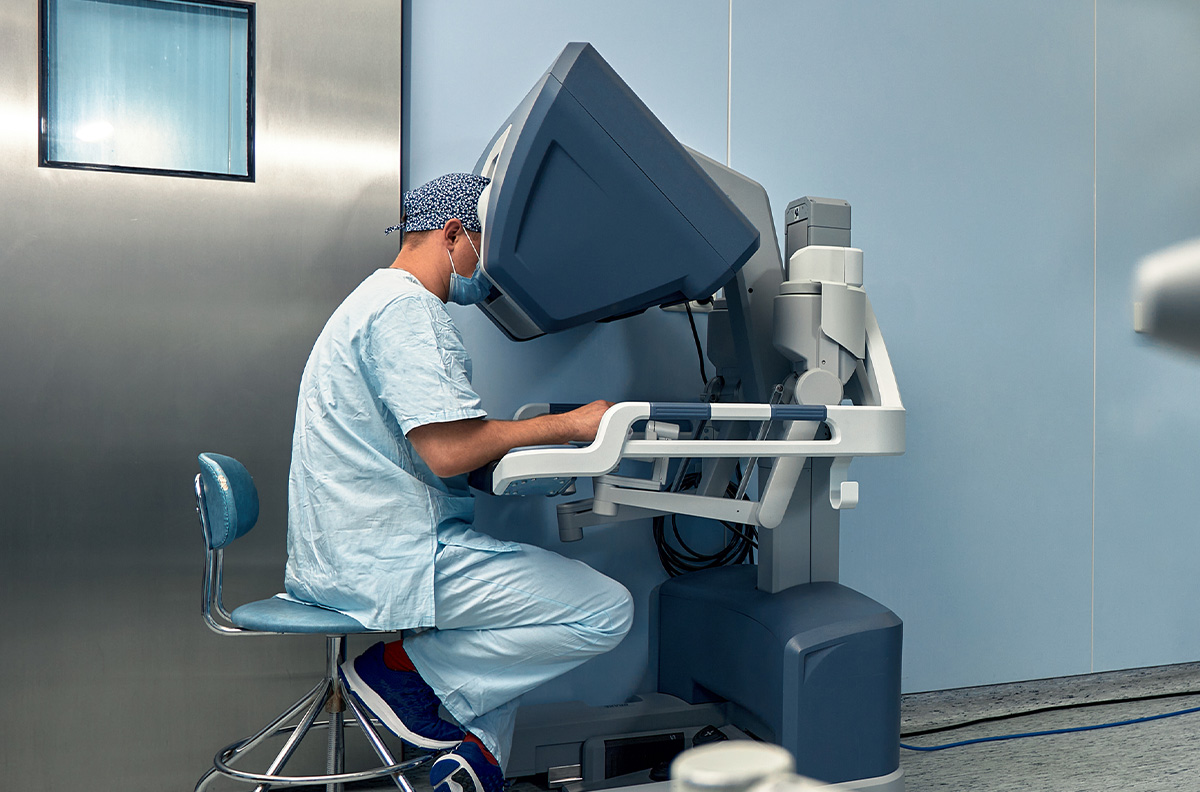Gastric Bypass
After a gastric bypass, you can easily shed your excess weight. Asst. Prof. Dr. Vahit Mutlu and his team will help you achieve a healthy and fit body through this operation.
Contents
Overview of Gastric Bypass Surgery
The number of surgical methods for treating obesity has increased over time. At the same time, existing surgical procedures have become more comfortable due to modern technological methods. Gastric bypass is one of these modern procedures. It is frequently chosen in bariatric surgery. During the operation, the stomach is significantly reduced in size compared to its normal capacity. This intervention also reduces nutrient absorption.
For those researching “What is gastric bypass?”, the amount of weight loss and the permanence of the results are common concerns. The weight loss achieved through this surgery is substantial. Food intake significantly decreases due to reduced appetite.
There are different types of gastric bypass procedures. One of them is the Roux-en-Y method, while another is the mini gastric bypass technique. Both techniques have certain differences. In the mini gastric bypass method, the newly created stomach is larger compared to the Roux-en-Y.
Additionally, the single connection in the mini gastric bypass makes it a simpler procedure. The patient’s medical history, current weight, and existing health conditions are considered when deciding on the type of surgery. The patient is informed about the requirements of the surgery by the physician. Preparing the patient, especially psychologically, is crucial, and professional support may be needed if necessary.
History of Gastric Bypass
The origin of gastric bypass surgery dates back to the 1960s when stomach surgeries were performed to eliminate ulcers. Modern procedures began to be implemented after the 1960s. Connecting the Roux-en-Y bowel loop to the stomach led to the current surgical procedure. Gastric bypass is the most common bariatric surgery method worldwide.
Who is Eligible for Gastric Bypass Surgery?
Those wondering “What is gastric bypass surgery?” also want to know if they meet the criteria for the procedure. The primary criterion is the body mass index (BMI), which should be 40 or higher. However, surgery can be performed at a lower BMI if the patient has obesity-related health issues that negatively impact their life.
If methods like diet and exercise have failed, or if the patient has conditions such as diabetes or joint problems, gastric bypass may be necessary. However, the surgery may not be an option for patients with alcohol or substance abuse problems, or certain psychological conditions. The physician makes a comprehensive risk assessment based on the patient’s current conditions.
In some cases, gastric bypass can be performed as a revision surgery. If a previous bariatric surgery did not result in significant weight loss, a revision surgery may be considered.
Preparation for surgery may involve various treatments such as medication or therapy. The patient’s support network also plays a crucial role in the process.
How is Gastric Bypass Performed?
Many are curious about “How is gastric bypass performed?”. Understanding the changes that will occur in the stomach post-surgery helps patients accept the process. The surgery is performed laparoscopically, with four 1 cm incisions in the abdomen. In some cases, the number of incisions may increase to six.
The stomach pouch is reduced by 95%. The new stomach is connected to the small intestine, significantly reducing absorption. The cut portion of the stomach is not removed, allowing stomach secretions to remain beneficial in the body.
The question “How long does gastric bypass surgery take?” also arises. The procedure takes at least one hour and can extend to three hours depending on the patient’s condition.
General anesthesia is used during the procedure to ensure the patient does not feel any pain. The patient typically stays in the hospital for 3-4 days post-surgery. A dietitian then provides a nutrition plan, and the patient should be monitored for at least a year by a dietitian, as well as by psychiatry and endocrinology specialists.
Advantages of Gastric Bypass Surgery
Gastric bypass offers several advantages, including cost-effectiveness. The procedure reduces nutrient absorption through the small intestine, preventing weight gain more effectively. Patients undergoing this procedure will not feel anything during surgery due to general anesthesia. The difference between gastric bypass and sleeve gastrectomy is often questioned. Gastric bypass is reversible, which is seen as an advantage.
Post-surgery, high cholesterol levels typically decrease, and conditions such as high blood pressure, sleep apnea, and type 2 diabetes significantly improve. Joint problems and leg swelling also tend to improve.
Rapid weight loss after surgery allows patients to move more easily and boosts self-confidence. The majority of excess weight is lost within the first two years.
Risks of Gastric Bypass Surgery
Although most patients have positive experiences with gastric bypass surgery, some risks and side effects can occur. It is crucial to have the procedure performed by a professional.
Common surgical complications, as well as specific risks associated with gastric bypass, can occur. Infection, bleeding, hernia, and blood clots are potential risks. Measures are taken during surgery to prevent these complications.
Other possible risks include anastomotic leakage, anastomotic stricture, ulcers, dumping syndrome, and vitamin and mineral deficiencies. However, all potential issues are managed with proper medical care, including supplements and medication.
Is a Diet Required After Gastric Bypass Surgery?
Post-surgery, dietary adjustments are essential. Patients should have three meals a day, focusing on protein-rich foods followed by grains.
For the first two weeks post-surgery, liquid foods are recommended. By the third week, pureed foods can be introduced. Patients should drink 1.5 liters of water daily, but not during meals.
Nutrient-rich foods are important due to reduced calorie intake. Slow eating is crucial, and meals should be consumed over approximately 45 minutes. Patients should stop eating once they feel full and keep a food diary.
Exercise is also recommended to prevent muscle loss and reduce sagging. Initially, light walks are suitable, gradually progressing to other exercises.
Avoid fried foods, snacks, packaged foods, carbonated drinks, and extreme temperatures in food.
Differences Between Gastric Bypass and Sleeve Gastrectomy
There are several differences between the two procedures. Sleeve gastrectomy does not involve the intestines, while gastric bypass connects the small intestine to the stomach pouch. Sleeve gastrectomy creates a banana-shaped stomach, while gastric bypass results in a small stomach pouch.
The recovery time for both surgeries is similar, but sleeve gastrectomy requires short-term vitamin and mineral supplementation, whereas gastric bypass requires lifelong supplementation.
Symptoms such as nausea, vomiting, diarrhea, and constipation are common but manageable with proper diet.
It is essential to follow the surgeon’s recommendations post-surgery. Light walking can prevent blood clots, and normal activities can resume within four weeks. Aerobic exercises should be delayed for a few weeks, with heavy exercises avoided for six weeks.
Research shows minimal differences in outcomes between the two procedures, but gastric bypass is more effective for obesity-related health issues. The surgeon will recommend the most suitable procedure, and patients should follow their advice.







